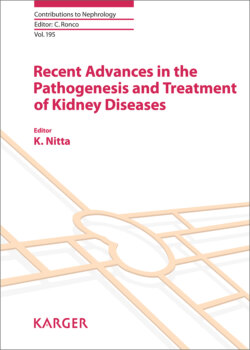Читать книгу Recent Advances in the Pathogenesis and Treatment of Kidney Diseases - Группа авторов - Страница 13
На сайте Литреса книга снята с продажи.
Albumin Transportation through Caveolae Glomerular Endothelial Cells
ОглавлениеIn our previous reports, we showed that Cav-1 is expressed very weakly in the glomeruli in 0-hour renal biopsy specimens of renal transplant donors as healthy control subjects; however, upon renal biopsy we found that Cav-1 expression significantly increased in glomeruli in patients suffering from glomerular diseases, such as IgA nephropathy, crescentic glomerulonephritis, minimal change disease, focal segmental glomerular disease, membranous nephritis, membranoproliferative glomerulonephritis, and diabetic nephropathy (Fig. 1b). Interestingly, in cases of glomerulonephritis that were treated with immunosuppressive agents and showed decreases in urinary protein excretion, the expression of Cav-1 decreased to a similar extent as it did in healthy controls. In this cohort of patients and healthy subjects, Cav-1 expression was positively correlated with urinary albumin excretion levels; further, Cav-1 co-localized with the pathologische anatomie leiden-endothelium (typically known as PAL-E) endothelial marker on histologic analysis. These results suggest that caveolae may play a pivotal role in the etiology of albuminuria, allowing albumin to pass through glomerular endothelial cells by a caveolae-dependent pathway [19]. To test this hypothesis, we utilized an in vitro study that employed human renal glomerular endothelial cells and found that Alexa Fluor 488-labeled albumin particles were highly co-localized with Cav-1, but not with clathrin, which was present in other invaginations on the cell surface. The caveolae-disrupting agents, methyl-beta-cyclodextrin (MBCD) and nystatin significantly decreased albumin internalization into glomerular endothelial cells, demonstrated by western blotting and immunofluorescence analyses. Upon siRNA knockdown of Cav-1 expression in glomerular endothelial cells, their uptake of albumin also significantly decreased. These results indicate that albumin enters glomerular endothelial cells through caveolae [20]. After the endocytosis of albumin through caveolae, albumin particles co-localized with early endosomes, but not with actin, microtubules, lysosomes, proteasomes, endoplasmic reticulum (ER), and Golgi apparatus (GA). We also showed that albumin particles were excreted to the other side of cells in a study using transwell plates. These results suggested that, after the endocytosis of albumin through caveolae, albumin was transported to early endosomes without moving along cytoskeletal components such as actin and microtubules, and that albumin particles were sorted at early endosomes for transport directly to the other side of the cells without undergoing either degradation in lysosomes and proteasomes, or modification in the ER or GA. In vivo analysis using the puromycin aminonucleoside (PAN) mouse model demonstrated that the amount of albuminuria significantly decreased following treatment with MBCD, as indicated by a decrease in Cav-1 expression in the capillaries [21]. Taken together, these analyses indicate that albumin is endocytosed, transcytosed, and exocytosed through glomerular endothelial cells via a caveolae-dependent pathway, and suggest that this caveolae-dependent pathway might provide an alternative etiology of albuminuria in addition to the classical fenestrae pathway.
